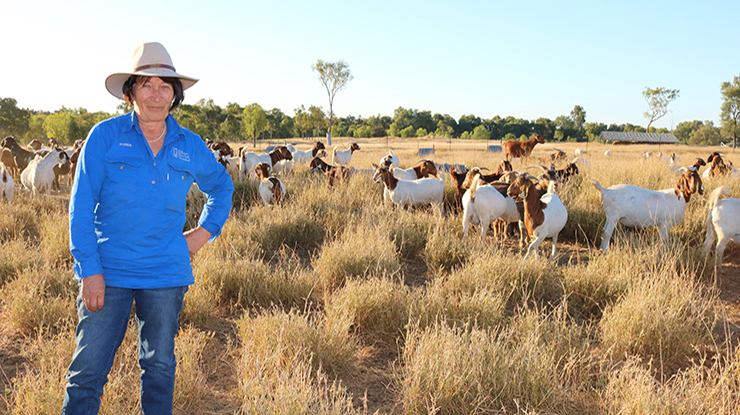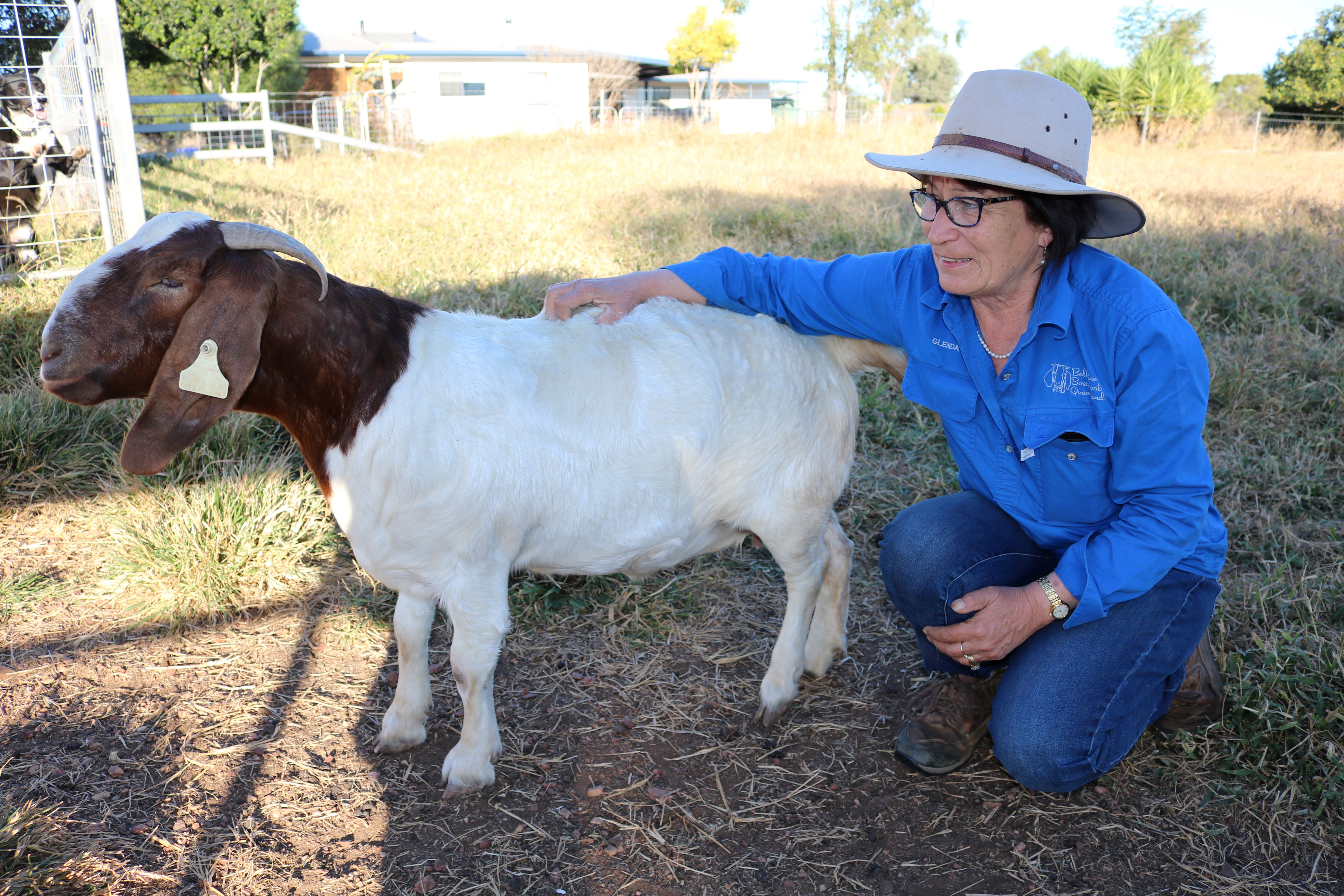Queensland breeder’s Mycoplasma warning
20 June 2023
 Glenda Henry, of Bellarine Boer Goats. Image: Melissa Aisthorpe, Dentsu.
Glenda Henry, of Bellarine Boer Goats. Image: Melissa Aisthorpe, Dentsu.
Key points:
- All breeds of goats are susceptible to infection with Mycoplasma ovipneumoniae.
- It can cause pneumonia and potentially death if not detected and treated early.
Queensland Boer breeder, Glenda Henry, is urging goat producers to be aware of a potentially deadly bacteria, Mycoplasma ovipneumoniae, that has claimed more than 300 of her goats.
Glenda says the impact of the bacteria has left a trail of physical and emotional stress in its wake.
A long-time breeder of both stud and commercial goats, Glenda owns Bellarine Boer Goats, near Emerald in central Queensland.
She describes the past two years as a “nightmare”, ever since Mycoplasma ovipneumoniae, a bacterial pathogen that infects the lungs of goats and sheep and can lead to pneumonia and potentially death, was unknowingly introduced to her herd.
“Mycoplasma ovipneumoniae is really insidious. Goats infected with it can show some symptoms of infection, or none at all, until it’s too late,” Glenda said.
“We now know animals can be carriers without any obvious signs of it. For the sake of the industry and animals, we need to get information out there about it because you can’t protect yourself and your animals from something that you don’t know about.”
How it started
Glenda’s experience with Mycoplasma ovipneumoniae began in February 2021 when she bought three new stud doelings.
“We followed all of our normal biosecurity protocols when they arrived at our property – they were quarantined and checked and cleared for worms before we put them out with our other maiden does,” Glenda said.
“It was a really dry winter and I started to see pink eye and pneumonia in some of the kids that year, and we lost some of them. I was blaming infection through dust and thought it was carrying some sort of pathogen.
“Kidding finished and everything seemed to be going ok, and then some of our maiden does started dying. We were getting autopsies done and sending samples off to pathology, but we couldn’t work out what was going on.
“By that stage, we had some rain and the creek had run, and with the creek run, we had some noogoora burr come down, which is highly toxic to goats at the two-leaf stage. I thought that was causing the deaths, but autopsies showed they had proteinaceous exudate in their chest cavities, which can be caused by Mycoplasma ovipneumoniae infection.
“The animals were in beautiful condition. They weren’t coughing and rasping, there was no laboured breathing. We lost over 300 animals, and we’re still losing them.”
More symptoms emerged at their next kidding.
“By the end of May 2022, when we started kidding, we had a couple of does with twins, but the majority of the does had quads and triplets. Apart from all the multiple births, I was starting to lose does during kidding. We had never lost does kidding because we don’t join animals that are compromised in any way.
“I had eight commercial does in the sick bay paddock. All of them survived, but in the pedigrees, it really hit them. A doe would suddenly start frothing at the mouth and vocalising because they were having issues breathing,” Glenda said.
Glenda said she contacted veterinarians and government authorities seeking help to diagnose the problem, but to limited avail.
“When you’re taking a ute load of dead goats away every day, it’s horrific,” Glenda said.
“I became manic. When I wasn’t checking the goats every two hours, I scoured the internet searching for an answer to what these crazy symptoms could be, because there is very little mention of Mycoplasma in the books I have.”

Glenda with one of her does that contracted Mycoplasma ovipneumoniae as a kid and is now blind in one eye as a result. Image: Melissa Aisthorpe, Dentsu.
PCR test developed
Glenda’s research led her to NSW-based veterinarian and research consultant, Dr Joan Lloyd, who has undertaken extensive research into Mycoplasma ovipneumoniae in the sheep industry.
Dr Lloyd visited Glenda and diagnosed Mycoplasma ovipneumoniae in her herd using the PCR test (nasal swab) she has developed for diagnosing the bacteria in sheep and goats.
If detected early enough, antibiotics prescribed by a veterinarian can be used to treat it, however, Glenda said her experience has shown that some animals continue to have ongoing health problems after they recover, such as blindness and joint issues.
“The moment I suspect an animal, they go on a treatment plan,” Glenda said.
“One of the first signs can be runny eyes, then the animals can be a little bit nasally. In my experience, it’s more extreme in the kids. They seem to get conjunctivitis badly and also swollen joints.
“Worms can be a secondary infection, as are the things that came back in some of our pathology results, such as Mannheimia. But they weren’t the cause of the illness, they were the secondaries.
“We also had healthy goats that were put down and pathologies done when we were trying to find out what the problem was.”
Uncertain future
Looking ahead, Glenda said the future is uncertain.
“We’ve still got 640 goats here. I haven’t joined this year because I’m too scared to,” Glenda said.
“Mycoplasma ovipneumoniae doesn’t affect the meat and there’s no zoonotic risk to humans eating the meat, so they can still go for processing.
“I have spent over $10,000 on trying to get to the bottom of this, and that’s not taking into consideration the value of the breeding animals I have lost.
“I don’t know if it’s going to be successful but I’m hoping in the long-term, for herd immunity. But there’s lots more research and development that needs to be done into this as well and I really want to be able to contribute to that.
“It’s why we started Queensland Goat Producers Inc, to share information, and we have more than 400 producers we currently send information to,” Glenda said.
Glenda said a shortage of veterinarians with knowledge and experience of goats is an issue that needs to be addressed.
“Vets need to listen to the owner and the people who actually live with the animals. The animal can’t talk but the owner can. We also need access to experts like Dr Lloyd,” Glenda said.
“If people are bringing animals onto their property, they need to be able to do swabs for Mycoplasma ovipneumoniae.
“It’s been an utter nightmare for us, but I’m the eternal optimist. I hope that the loss of my animals and the trauma we have been through can accelerate help for others goat producers.”
What is Mycoplasma ovipneumoniae?
According to Dr Joan Lloyd, detection of Mycoplasma ovipneumoniae in goats is becoming increasingly common in Australia.
There are several different types of mycoplasmas that infect Australian goats. All breeds of goats are susceptible to infection with Mycoplasma ovipneumoniae.
Mycoplasma ovipneumoniae often enters an uninfected herd via chronic carrier bucks or does that are showing no outward signs of infection. It is also spread at shows and by fence line nose-to-nose contact with other goats and sheep.
Infection persists in a herd in chronic carrier does and bucks, with infection passing from does to kids soon after birth.
Does shed the bacteria from their nose and throat, as well as in their milk.
Infected does and bucks may show no outward signs of infection, or may be coughing, wheezing, have runny eyes, breathe heavily after exertion, or simply be found dead.
Infected does also have an increased risk of mastitis.
When detected early, infection with Mycoplasma ovipneumoniae can be treated.
Dr Lloyd advises that every goat herd should have an animal health plan that includes a biosecurity plan aimed at preventing Mycoplasma ovipneumoniae and other goat pathogens entering the herd.
Animals that attend shows and all new arrivals should be quarantined and tested prior to introduction into the herd.
Ask suppliers about their pneumonia status. Check introduced goats for ear mites and treat if required. Do not feed colostrum sourced from other goat herds or from cattle to goat kids.


